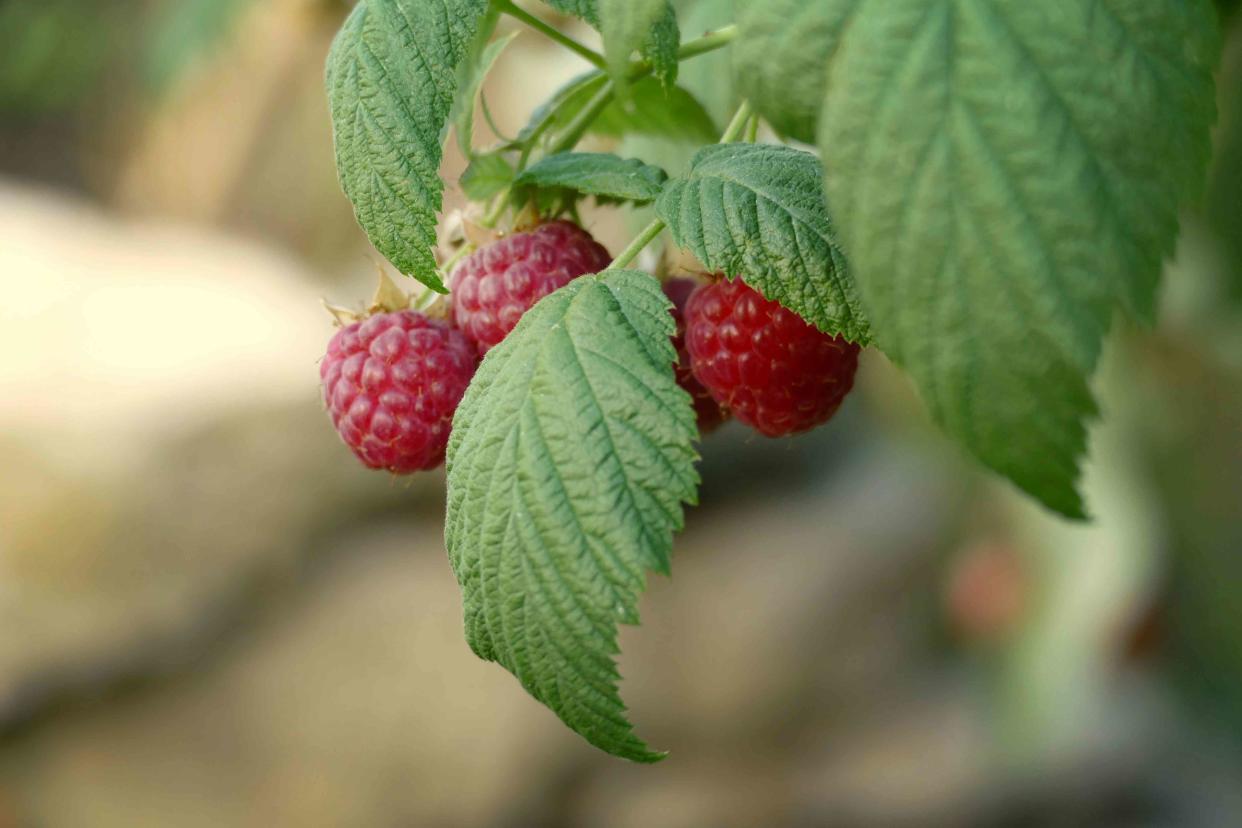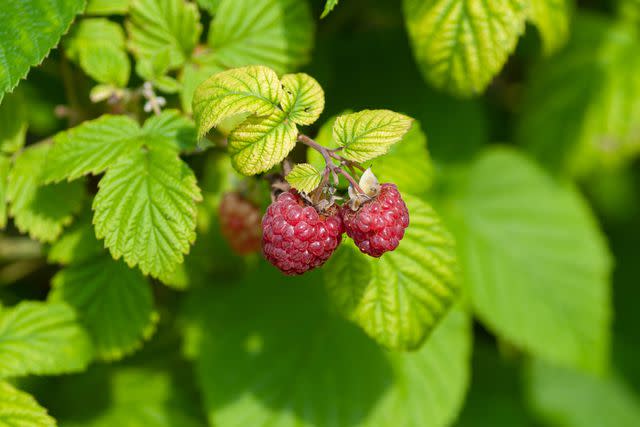How to Grow and Care for Raspberry Bushes in Your Home Garden

Maria Hossmar / Unsplash
Raspberries (Rubus idaeus), as thorny and imposing as they may be, are responsible for producing soft, red jewels of fruit. They hail from the same genus as blackberries, and while their fruits take on similar shapes and textures, there are a few differences.
Growing raspberry bushes at home is completely possible. Many varieties cross a range of USDA zones, making it fairly easy to find a type that will thrive in your location.
If there's a sunny patch in your garden that's missing some kind of plant, it's worth considering raspberries—they take a little while to fruit but will continue to blossom and produce year after year with the right care.
Common Name | Raspberry |
Botanical Name | Rubus idaeus |
Family | Rosaceae |
Plant Type | Fruit |
Size | Up to 6 ft. tall |
Sun Exposure | Full sun |
Soil Type | Well-draining, rich soil; compost mixed in |
Soil pH | Slightly acidic |
Bloom Time | Summer and fall |
Hardiness Zones | 3–8 USDA |
Native Area | North America and Asia |
How to Plant Raspberries

The Spruce / Evgeniya Vlasova
Raspberry canes can really stand out in a garden with their bright green bushy leaves, white flowers, and red fruits. If visions of overgrown, thorny bushes are popping up in your head, don't fret—there are many ways to manage and maintain healthy raspberries.
When to Plant
Raspberries should be planted in early spring. It's possible to start planting towards the end of fall if you're in an area that doesn't get extreme winters. To find the perfect time for planting, find out the last frost date in your zone and plant after that has passed.
Selecting a Planting Site
Choose the sunniest area of your garden, even if it's prone to partial shade. Raspberries can still grow in these conditions, just ensure the bushes have enough space for their canes and root system to spread out. There should also be room for adding stakes or trellises to support the plant as it grows.
Spacing, Depth, and Support
You'll want to leave at least 18 inches between each cane you plant or seed you sow. Raspberries' root systems are on the shallower end, so you'll only need to push seeds in about 2 to 3 inches deep. These plants also need support for them to stretch horizontally and vertically.
Trellises and stakes are suitable for smaller gardens—but for a larger row of raspberry plants, installing wooden posts into the ground with wire between is best.
Want more gardening tips? Sign up for our free gardening newsletter for our best-growing tips, troubleshooting hacks, and more!
Raspberry Bush Care
These plants have a few requirements: sunlight, water, soil, and pollination are all key components to nurture a raspberry plant and help it thrive.
They appreciate slightly acidic soil, plenty of light, and need pollinators around for their fruit to form properly and produce a sizable yield. While it may seem like a hefty job, they're relatively low-maintenance.
Light
It's best to place raspberries in an area that gets full sun. Optimal conditions provide raspberries with 6 to 8 hours of sunlight each day.
Soil
Raspberries appreciate richer soils, so amend yours by adding compost and manure. Loam soil is also great. The goal is to offer the plants a foundation that's nutrient-dense but drains well, too.
Sulfur and lime are helpful additives for influencing the pH of your soil if it's not right for your raspberry bush. Sulfur can make it more acidic, whereas lime will increase the alkalinity.
Soil PH
Soil pH does have an impact on raspberry bushes. These plants prefer a pH between 5.5 to 6.5.
Water
Raspberries need roughly an inch of water per week, but it's best to provide them with regular watering rather than one weekly deep soak. Avoid getting the fruit and leaves wet, as this can lead to disease and the fruit is prone to mold.
For ease, drip irrigation set-ups are often used. With a little mindfulness of how you water them and a well-draining soil, they should be just fine.
Temperature and Humidity
Raspberries do completely fine in areas that remain cool throughout the year. Colder temperatures aren't detrimental to raspberries, and they usually prefer milder weather. However, there are some varieties that have been cultivated to handle hot summers, too.
Fertilizer
Fertilizer is a helpful way of supporting healthy growth in your raspberry plants. A slow-releasing fertilizer with nitrogen is recommended, and it's best to provide raspberries with fertilizer before the sun is high in the sky or after it has gone down.
The best time to fertilize them is in early spring (about two weeks after planting) before major growth and fruit production occurs.
Pollination
Raspberries are self-pollinators, which makes it easier on gardeners in terms of care. Honeybees are the primary insect that helps with this process, which not only helps your raspberry bushes but boosts the biodiversity in your garden, too.
Pollination is essential for the proper formation of a raspberry. Without it, the drupelets won't be healthy or fully formed enough to create a whole berry.
Types of Raspberry Plants
'Amity': This variety produces large and sweet bright red fruits. It's a fall-bearing variety and extremely hardy when it comes to diseases and winters.
'Boyne': Mildly sweet and a floricane-variety, Boyne raspberries are fine for eating but ideal for making jams, jellies, chutneys, and other preserves.
'Heritage': This variety can handle hot summers and produces a healthy crop. They're primocane berries and are an easy type to grow.
'Willamette': For plenty of fruit that lasts, you can lean on the old and reliable Willamette variety, named after the location where it was cultivated in Oregon.
'Nova': This floricane-bearing berry is capable of adapting to different climates. It produces good yields and is slightly tart.
Primocane-Bearing Raspberries vs. Floricane-Bearing Raspberries
There are two types of canes within raspberry bushes: primocane-bearing and floricane-bearing. It can seem confusing at first, but you'll understand the difference in no time, which will help with harvesting, pruning, and overwintering your raspberry bushes.
Primocanes
The first-year canes on a bush
Thick and green
Some varieties of raspberries can produce fruit on primocanes
Fruit is harvested in the summer and fall in the first year
Floricane
AKA "summer bearing"
Do not produce fruit in the first year
Harvesting Raspberries
One of the fantastic things about this plant is how easily its fruit comes off the cane—when it's ready, that is. Using your thumb and forefinger, slightly tug or twist, and the berry should slide right off. You can wear gloves to prevent irritation from thorns when moving the canes.
You'll know a raspberry is ripe when it's no longer green and is fully saturated. The color will depend on the variety, but it will typically be a bright, rosy red, golden yellow, or deep purply red.
Green to greenish-pink berries indicate that they're still growing—as is any resistance when you tug at the berry—and it's better to leave these to continue to ripen.
How to Grow Raspberries in Pots
Raspberries are usually grown in the ground or raised beds, but it's possible to plant them in pots. Containers should be large enough to hold the bush and account for its growth and have drainage holes to prevent root rot.
The best way to ensure this is by selecting smaller varieties that don't tend to spread as much as others. These include Malling Jewel, Ruby Beauty, Yummy Dwarf, Zeva, September, Malling Promise, and Autumn Treasure.
Give them the same care as you usually would—plenty of sun and ample water—but aim to put your bushes in a spot that protects them from heavy winds.
Pruning
Pruning and cutting back raspberries is a vital part of ensuring they'll grow back and serve as a long-lasting perennial. Do an initial pruning early in spring to get rid of dead canes or anything that's diseased or suffocating other healthy growth.
Propagating Raspberries
The easiest way to propagate raspberries is through primocanes, also known as suckers. Suckers are fresh raspberry plants that pop up near your bush—raspberry canes are quick growers after all. To propagate from suckers:
Wear gloves to protect your hands from prickly canes and stems.
In early spring, select a few suckers that are around six inches tall and separate from your main bush.
Carefully pull out the sucker from the soil. If necessary, you may need to dig around the plant to loosen the roots. The root system should be small enough that it won't put up too much of a fight.
You can divide the sucker root systems if they're larger and then transplant them into your intended area.
To propagate raspberries from cane cuttings:
Use gloves to protect your hands, then with a pair of sharp and clean secateurs or shears, cut off a section of cane that's 6 or 7 inches tall.
You can use a rooting hormone to support growth, but it's not essential.
Push the end into your new soil patch, leaving about half to 1/3 of the cane sticking out of the dirt.
The can should form its root system and begin to grow as its own bush. Depending on the type, it can take a year or two for fruiting to happen.
Overwintering
Raspberries are dormant in the winter and will not require as much water. Ensure you prune your plants back, which directs energy to their root systems. Don't worry too much, as their canes will return in the spring.
Mulch around the soil can help with maintaining a more consistent temperature. For the most part, raspberry bushes tend to do okay and are built for overwintering. Raspberries in containers can be moved into a different area of your garden that gets shelter from wind and any heavy rain or snow.
Common Pests and Plant Diseases
Raspberries are appealing not just to gardeners, but quite a variety of pests, too. Japanese beetles, sap beetles, aphids, spider mites, spotted wing drosophila, and leafhoppers are a few of the bugs that enjoy chomping away.
Small mammals also enjoy eating parts of the raspberry plant, including squirrels, chipmunks, rabbits, and deer. Pest nets, oils, and repellant soaps and solutions can all be beneficial.
As for diseases, raspberries are typically afflicted by spur blight, powdery mildew, botrytis fruit rot, cane blights, root rot, late leaf rust, and verticillium wilt.
Some varieties of raspberries are more susceptible than others to particular diseases. There are multiple ways to handle these problems, through pruning and fungicidal sprays.
Frequently Asked Questions
Are raspberry bushes easy to grow?
Raspberry bushes are relatively easy to grow and care for. Gardeners who are aware of the plant structure and fruiting periods and who provide the right sunlight, water, support, and soil conditions will see their raspberries thrive and produce fruit for many years.
How long does it take to grow raspberries?
Primocane raspberries can produce fruit in the first year of planting. Floricane varieties will produce fruit the second year. Once they're planted, raspberries fruit in early summer to early fall.
Do raspberries come back every year?
Yes. Raspberries are perennial. They'll be dormant in winter months, but the bush will sprout new primocanes and its old primocanes will turn into floricanes the next year. With the right care, this cycle often continues for 10 years, but some can live up to 20 years.
Can you grow raspberries indoors?
Raspberries are rarely ever grown indoors. They need space to grow, pollination, and sunlight. While it's not impossible, it's not the recommended method for growing healthy, thriving bushes.
Read the original article on The Spruce.

